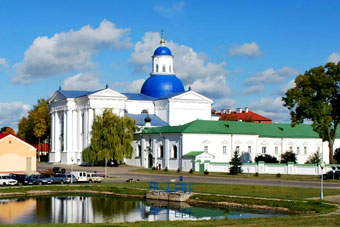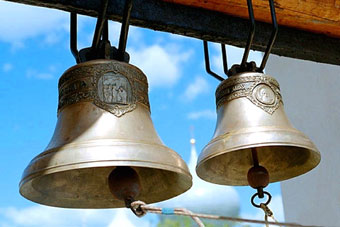Orthodoxy in Belarus
Orthodoxy (in translation from Greek - "correct knowledge", "correct teaching") is one of the directions of Christianity, formed in the first millennium AD. In the Eastern Roman Empire. Orthodoxy considers itself a true apostolic faith, embodied in the Holy Scriptures and the Sacred Tradition. The Orthodox Church considers itself the only church the founder and head of which is Jesus Christ.
The Orthodox dogma is based on the Holy Scripture (Bible) and the Sacred Tradition, which includes the decrees of the Ecumenical Councils. Orthodox believers also believe in God the Father, God the Son and the Holy Spirit. The Church considers these three images inextricably linked to each other. In Orthodoxy there is no clearly defined number of sacraments. Numerous church leaders have different points of view on this issue. Nevertheless, baptism, church marriage, chrismation, eucharist (communion), confession, deification, priesthood are considered Orthodox mysteries as well as Catholics. Sometimes to this list still carry burial and monastic tonsure.
The history of Orthodoxy in the Belorussian lands dates back to 988, when the Kiev prince Vladimir baptized the inhabitants of Kiev in the Dnieper and sent Greek bishops to baptize the subjects of all Kievan Rus. Already in 992 the Polotsk Diocese was founded. Approximately in 1000, the Polotsk Princess Rogneda founded a monastery in Izyaslavl.
You can not ignore the activities of the patroness of the Belarusian lands Euphrosynia Polotskaya. . Having taken monastic vows at the age of 12, Euphrosynia contributed in every way to the development of Orthodoxy in the Polotsk principality. She rewrote church books, opened a school for children, in which she taught. By the order of Euphrosynia, the master Lazar Bogsha made a unique wooden cross, covered with gold and precious stones, which became one of the main Orthodox relics of Belarus. Efrosinia also founded her own monastery in Polotsk.
In the Grand Duchy of Lithuania, Orthodoxy was one of the dominant religions. In 1315 in Novogrudok an Orthodox department was formed, headed by the Metropolitan. As a result of the unification of the Orthodox and Catholic churches in 1596, the number of Orthodox believers began to decline. This was facilitated by the active polonization of the Belarusian lands: the planting of Latin elements in the Uniate worship, the conduct of divine services in Polish.At the end of the 18th century the Belarusian lands were completely incorporated into the Russian Empire and the positions of Orthodoxy are again beginning to strengthen. The churches that were closed earlier are opened, the Catholic churches are re-ordained.




After Belarus became part of the USSR, a large-scale campaign against religions begins in the country. Monasteries, seminaries and temples were massively closed, their property was subject to nationalization. Almost until the collapse of the USSR, the activities of any religious institutions were banned.
Today, the Orthodox Church is the largest religious denomination in Belarus. According to the 2009 census, almost half of the country's total population (4.5 million) is Orthodox.
In Belarus, many churches and monasteries have been preserved. The main Orthodox church is the Cathedral of the Holy Cross in Minsk. It is here that the miraculous Minsk Icon of the Mother of God is located. According to the legends, the inhabitants of Minsk saw an image floating along the Svisloch in the area of the Minsk castle. The townspeople took the icon out of the water and put it in the castle of the Nativity, the Mother of God church, where the image was before 1616. In the northern part of the capital is located St. Elisabeth Convent founded in 1999. The monastery has numerous workshops, a refectory for pilgrims and several monastery shops.
One of the main Orthodox shrines is the complex of the Polotsk Savior-Euphrosyne monastery founded by Saint Euphrosynia Polotskaya in the 12th century. The Savior-Euphrosyne Monastery was one of the first female Orthodox monasteries in Belarus. In the monastery are stored precious orthodox relics. It is the relics of the Monk Euphrosynia Polotskaya and a copy of the 12th century cross, decorated with precious stones and metals. Also on the territory of the monastery is the Transfiguration Church built by the architect Ioan, commissioned by St. Euphrosynia in the first half of the 12th century.
On the site of the village of Pustynka, Mstislavsky district, Mogilev region, there is a functioning Orthodox Uspensky monastery. This monastery is notable for the fact that it is surrounded by a miraculous crinse, which has curative properties. Another sign of God's grace is the manifested face of Jesus Christ on one of the walls of the Intercession Church.
The unique Zhirovichi Holy Assumption Monastery operates in the Slonim district of the Grodno region. The monastery owes its appearance to the Miraculous Image of the Mother of God Zhirovichskaya. In 1494, local shepherds discovered an icon in the branches of a tree in the depths of the forest and carried it to the owner of a small town that erected a church in honor of the image of the Mother of God. The monastery found its modern appearance in the 17th-18th centuries.
You can get acquainted with the Orthodox culture and traditions of Belarus by ordering an excursion or an individual tour on our website:
- You can visit the center of Orthodoxy in Belarus by ordering an excursion to Polotsk. During the tour you will see the St. Sophia Cathedral and the Savior-Euphrosyne monastery.
- After choosing the tour Slonim - Zhirovichi - Synkovichi you will see the architectural ensemble of the former Bernardine monastery in Slonim, visit the largest in the territory of Belarus the orthodox male Zhirovichi monastery and the unique monument of Gothic architecture of the 16th century Synkovichi Church of St. Michael.
- If you choose a tour of the Temples of Minsk you will be able to see not only the secular sights of the city, but also temples, such as Cathedral of the Holy Cross is an architectural monument of the 17th century in the Vilna baroque style, where the miraculous icon of the Mother of God of Minsk, St. Elizabeth's Monastery is kept.
To enroll and order these and other excursions on religious topics, get acquainted with the culture and traditions Belarusian Christians you can by ordering an excursion on our portal: Application for tour organization
